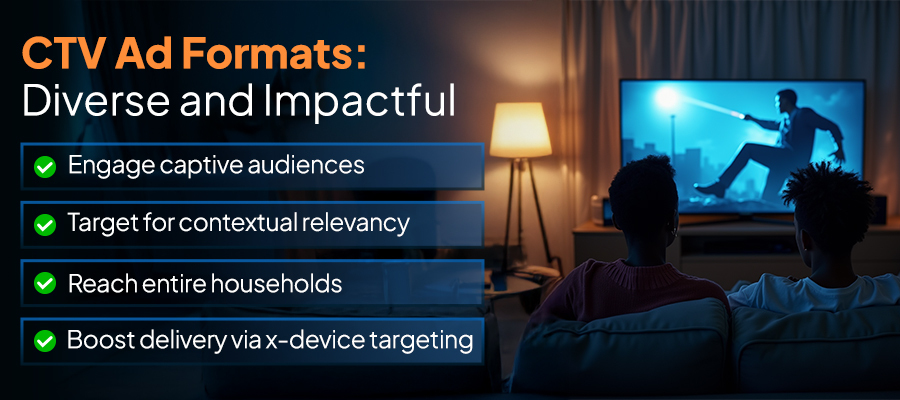We live in an age where consumers are an index finger away from choosing the ads they watch. We’ve moved from passive viewing to engaged and participative audiences.
No longer do teens rush to the fridge between T.G.I.F commercial breaks, or viewers flick through the guide to line up tonight’s TV entertainment. In today’s digital TV landscape, users want choice.
With this shift in personalization, reliance on devices, attention, and dominance in mobile attention, there have been some impressive innovations in ad formats fit for Connected TV (CTV). Advertisers considering campaigns for Smart TVs, gaming consoles, tablets, and mobile devices, now all play the potential role of film director–and that’s a powerful scene to take part in.
Run-of-the-mill commercial breaks don’t make the cut anymore. With Connected TV (CTV) advertising, the traditional 30-second spot is just the tip of the iceberg; utilizing creative advances and a plethora of media potential is key to success. In this blog, we’ll walk you through why consumers want to see ads that are just as engaging as the content they’re watching itself, and build ad strategies that can capture–and keep–their attention.
Breaking Down CTV Ads
CTV ads come in an array of formats, each with its own unique function and potential to captivate target audiences. From in-stream ads that seamlessly blend into your media content to interactive formats that turn passive watching into an engaging two-way street, the possibilities rival available streaming options.
But don’t rush into creating your CTV ad just yet. The choice is more important than you imagine. You wouldn’t want to present a lengthy, cinematic ad to someone who’s watching a quick YouTube tutorial, or worse, interrupt a nail-biting season finale with a poorly timed interactive quiz or a boring ad. The right format and content can be the difference between a viewer accessing their digital wallet, positive brand recall, or zapping to another channel.
In our last article, we told you why CTV advertising matters and why you should hop on the CTV train as a marketer. For this blog, we will show you the power of different CTV ad formats in growing your conversions and which ones you you should consider investing in.
Getting to Know the Various CTV Ad Formats
To determine which ad you should create for your CTV campaign, you must know your options first. We will tackle each format so you can understand what you’ll be dealing with and actually succeed in launching your campaign.
1. In-Stream Ads
In-stream ads are a cornerstone of CTV advertising, appearing within the content itself. These are concise and snappy ads placed within video content that begin playing while you’re enthralled in a mid-watch session. They come in three primary formats: pre-roll (before the content), mid-roll (during the content), and post-roll (after the content).
Pre-Roll Ads
Pre-roll ads play before the main content, so they catch viewers when they are most attentive and enthusiastic. These ads typically last from 15 seconds to a minute and get higher completion rates compared to other formats, with non-skippable pre-rolls reaching up to 80% completion rates.
The benefits of pre-roll ads are:
- Higher engagement: Viewers find pre-roll ads 3.5 times less interruptive than outstream and mid-roll formats. They don’t see pre-rolls as much of a bother and would likely tolerate them.
- Increased ad recall: Even ads viewed for less than one second can increase brand awareness and purchase intent, so placing them at the start of the content already makes a difference whether people finish watching them or not.
- Captive audience: Viewers are more receptive to pre-roll ads as they anticipate their chosen content.
To make your pre-roll ads more effective, focus on grabbing attention within the first 5 seconds, keep the messaging precise, and include clear calls-to-action (CTAs).
Mid-Roll Ads
Mid-roll ads, strategically placed within ongoing content, rely on viewers’ already-invested attention. These ads go on for 15-30 seconds and are often inserted at natural breaks to minimize disrupting the viewing experience. Instapage reports that platforms like YouTube and Facebook reach completion rates as high as 90% for mid-roll ads, largely attributed to their integration in the content flow.
While mid-roll ads excel at brand recall— achieving a 27% message recall rate, more than pre-roll’s 24%— they face challenges such as lower click-through rates due to viewers’ reluctance to leave their locked-in content. However, the same source declares mid-roll CTAs outperform pre and post-roll placements, with a conversion rate of 16.95% compared to pre-roll’s 3.15% and post-roll’s 10.98%.
For mid-roll ads, a storytelling approach is necessary to optimize performance. You must also reveal branding within the first three seconds and design for sound-off situations since some users prefer to mute their media.
Post-Roll Ads
Emerging after the content concludes, post-roll ads have a particular edge despite having lower engagement rates. Since viewers have already completed watching what they came for, the completion rate drops more than pre-roll or mid-roll formats. Nonetheless, they still provide value for reinforcing brand messages to dedicated viewers.
The benefits of post-roll ads are:
- Cost-effectiveness: Post-roll ads are often less expensive than pre-roll or mid-roll placements.
- High-intent audience: Viewers who reach the end of the content prove themselves to be committed, so they’re also likely willing to click through CTAs. Post-roll ads excel in driving immediate action, with SiriusXM Media showing they outperform pre-roll ads by over 4 percentage points in purchase conversion.
- Non-disruptive: Since post-rolls only appear after the content, they don’t interfere with the viewing experience, creating a more positive impression on the audience.
Direct, compelling content with clear calls-to-action is what works best for post-roll ads since these appeal to the viewer’s satisfaction of completing their content, leaning on their fulfillment for conversions and engagement. It might be a great space to explore rewarded experiences and messaging.
Those three types of in-stream ads offer superior performance compared to other digital video formats. LiveRamp attests that they achieve completion rates of over 95% and engagement rates that are 4.6 times higher than mobile video and 10.3 times higher than desktop video. An article from StreamTV Insider also states that interactive in-stream formats, such as trivia units, polls, and carousels, further increase engagement, with trivia ads showing the highest engagement rate at 2.53%.
2. Interactive Ads
Interactive CTV ads shake things up as they change passive advertisements into dynamic environments where the audience can take part, spiking engagement rates and encouraging brand recall. These ads incorporate clickable elements, QR codes, and gamification features to prompt user participation.
Because of their fun and involving nature, Kortx mentions that interactive CTV campaigns have demonstrated a 5.42% engagement rate, significantly outperforming mobile and PC counterparts at 0.97%. They attain a 52% lift in viewer attention and generate 79% stronger aided brand recall compared to standard video ads.
With interactive CTV ads, you can even collect valuable consumer insights through surveys and polls, recording user choices that can guide future campaigns. Moreover, you can trigger sales if you opt for a function that enables direct purchases or add-to-cart buttons.
Benefits aside, there are still drawbacks to keep in mind. Interactive CTV ads come with their challenges, including higher production costs and CPMs (cost per mille) that are 10-15% above industry standards. It is recommendable to have a considerable budget and a skilled team to create the ad itself. Moreover, the integration must be smooth and the interactive elements should complement rather than disturb the viewing experience.

3. Pause Ads
Pause ads represent a novel and non-intrusive CTV advertising format, cropping up when viewers manually pause content. You would see them in the form of static images or brief animations, commanding the target audience’s attention without cutting off the content. This format rides on natural user behavior, with data showing users pause content 4-5 times daily, 90% of these pauses lasting under 10 seconds. That’s a lot of opportunities to get your message out there!
Because these ads don’t disrupt the content and take up idle screen time instead, they become more appealing to viewers. They also have more impact and viewability as the user is expected to return to their paused content, improving the likelihood of them seeing the ad that’s playing on the screen while their movie, episode, or video is on hold in the background. It’s even better if the algorithm recognizes your CTV ad to be contextually relevant to the paused content because it would be placed in front of an interested audience.
Unfortunately, the fact remains that pause ads face issues like limited engagement time due to the audience’s eagerness to get back to their paused media and potential viewer fatigue when the algorithm shows them the same ads again and again with every pause. To avoid these, form CTV ads with captivating, diverse visuals and messaging that are related to the target content or user preferences.
4. Overlay Ads
The ads that show on the periphery of the television screen while you’re watching are overlay ads. They appear as small banners or graphics superimposed on the content, typically in a corner or along the bottom of the screen with clickable elements. Since they’re found at the edges, they don’t affect playback at all and they usually won’t go away unless closed by the user. Because of this, they’re more memorable than standard video ads by 4 times and amass 72% more savings for advertisers.
What’s amazing about overlay ads is that they have lower perceived ad frequency. According to Digiday, when exposed to four overlay ads, viewers regarded an average of 1.72 ads, compared to 5.33 ads for six video ads. Only 17% of these viewers agreed or strongly agreed that overlay ads bothered or distracted their viewing experience, so the other 83% are fine with overlay ads peeking at the sides.
Another advantage of overlay ads is that you have more opportunities for ad placement without extending ad breaks. As mentioned before, they appear with the content and will likely stay where they are until the viewer removes them. Like pause ads, they can align with and show up in the right media. They also require lower fiscal and time investments compared to traditional video ads.
If you want to launch overlay ads, you should consider contextual placement and incorporate elements like QR codes or countdown timers to tap into the audience’s curiosity and sense of urgency.
Picking for Purpose: Which CTV Ads Should You Run?
All CTV ad formats come with certain benefits, as well as characteristics that might not be the best fit for your app or brand. When selecting the right format for specific campaigns, consider your objectives and target audience, and consult an expert inventory partner to align your goals.
What do we suggest?
- Brand awareness: Pre-roll ads excel at capturing attention early, while interactive ads boost unaided recall, so these two are best for establishing your brand presence.
- Engagement: You can achieve the most engagement with interactive ad formats like mini-games or polls that can urge viewers to take action.
- Conversion: Post-roll and mid-roll ads both result in high conversions. If you want to secure leads and sales, these are the ads to run.
- Contextual relevance: Dynamic Ad Insertion (DAI) allows real-time ad placement based on viewer data and content. Pause ads and overlay ads will work well for this function because they can match with related content without interrupting it.
The list above will give you an idea, but why choose only one when you can combine two or more together? This is great if you have more than one purpose for launching your CTV ad campaign. It can be especially powerful when combined with crossdevice campaigns. No matter the case, always prioritize high-quality content tailored to your audience’s interests and viewing habits.
In Summary
We’ve taken a whirlwind tour through the CTV ad formats that are shifting how audiences interact with commercials during binge-watching sessions— from the classic in-stream ads that pop up before, during, or after your favorite shows to the attention-grabbing overlay ads that catch you right as you’re settling in.
Selecting the right ad format is all about making the right impression at the right time. Want to make your brand known? Pre-rolls are your best friend. Looking for engagement? Interactive ads are ready to mingle. Need those conversions? Post-rolls and mid-rolls are waiting to seal the deal. Looking to place your ad in front of the right audience? Overlay and pause ads are the way to go.
In CTV advertising, you must aim beyond getting seen. Be remembered and make a mark, turning TV-fanatics into active customers. Pick the best CTV ad format for your goals and your audience might just find themselves talking about the commercial break they saw at their next dinner party!
We have a lot more in store for you in the next article of our CTV series. If you want to let CTV experts take charge of your ad strategy through managed-service, you can contact our team.



